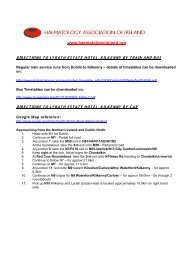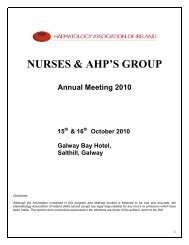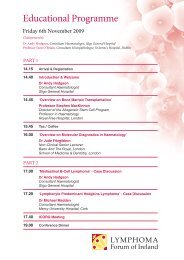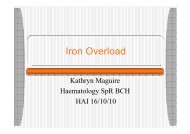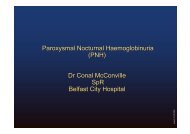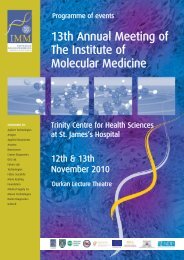Guidelines on Diagnosis and Treatment of Malignant Lymphomas
Guidelines on Diagnosis and Treatment of Malignant Lymphomas
Guidelines on Diagnosis and Treatment of Malignant Lymphomas
Create successful ePaper yourself
Turn your PDF publications into a flip-book with our unique Google optimized e-Paper software.
Extra-nodal Marginal Z<strong>on</strong>e B-Cell<br />
Lymphoma (Malt-Lymphoma)<br />
Definiti<strong>on</strong> <strong>and</strong> Incidence<br />
Extranodal Marginal Z<strong>on</strong>e B-cell Lymphoma <strong>of</strong> Mucosa<br />
Associated Lymphoid Tissue (MALT Lymphoma) is an extranodal<br />
lymphoma c<strong>on</strong>sisting <strong>of</strong> heterogeneous small B-cells. The<br />
gastrointestinal tract is the comm<strong>on</strong>est site <strong>of</strong> development <strong>of</strong><br />
MALT lymphoma, <strong>and</strong> the stomach is the most comm<strong>on</strong> locati<strong>on</strong><br />
(85%). Gastric MALT lymphoma is c<strong>on</strong>sidered to be derived from<br />
MALT acquired as a result <strong>of</strong> Helicobacter pylori infecti<strong>on</strong>. The<br />
incidence is 0.6 new cases / 100,000 populati<strong>on</strong> per year, median<br />
age 60 years <strong>and</strong> sex ratio shows a slight female excess.<br />
ICD-O Code 9699/3<br />
Clinical Presentati<strong>on</strong><br />
Most patients have a history <strong>of</strong> chr<strong>on</strong>ic inflammati<strong>on</strong>, sec<strong>on</strong>dary<br />
to autoimmune disorders or low grade infecti<strong>on</strong>s which result in<br />
accumulati<strong>on</strong> <strong>of</strong> extranodal lymphoid tissue. Examples include<br />
Helicobacter pylori associated chr<strong>on</strong>ic gastritis, Sjogren’s<br />
Syndrome or Hashimoto’s thyroiditis. Helicobacter pylori is<br />
detectable in most cases <strong>of</strong> gastric MALT lymphoma. Patients<br />
with Sjogren’s syndrome <strong>and</strong> lymphoepithelioid sialadenitis have<br />
a 40-fold increased risk <strong>of</strong> developing lymphoma, <strong>and</strong> most <strong>of</strong><br />
these are MALT lymphomas. Patients with Hashimoto’s thyroiditis<br />
have a 3-fold increased risk <strong>of</strong> lymphoma development. Most<br />
patients present with Stage I or II disease, but 20% <strong>of</strong> patients<br />
have b<strong>on</strong>e marrow involvement. Multiple extranodal sites are<br />
present in 10% <strong>of</strong> patients at presentati<strong>on</strong>, with 30% becoming<br />
disseminated over time, <strong>and</strong> some transforming to DLBCL.<br />
The 5-years overall survival is >80%.<br />
Pathology <strong>and</strong> Genetics<br />
The lymphoma cells infiltrate around reactive B-cell follicles,<br />
external to a preserved follicle mantle, in a marginal z<strong>on</strong>e<br />
distributi<strong>on</strong>, <strong>and</strong> spread out to form larger c<strong>on</strong>fluent areas<br />
which eventually overrun some or most <strong>of</strong> the follicles. The<br />
characteristic marginal z<strong>on</strong>e B cells have small to medium sized,<br />
slightly irregular nuclei with moderately dispersed chromatin<br />
<strong>and</strong> inc<strong>on</strong>spicuous nuclei, resembling those <strong>of</strong> centrocytes with<br />
relatively abundant, pale cytoplasm. Plasmacytic differentiati<strong>on</strong> is<br />
present in approximately <strong>on</strong>e-third <strong>of</strong> gastric MALT-type<br />
lymphomas. Lymphoepithelioid lesi<strong>on</strong>s are usually present.<br />
Phenotype:<br />
CD19+ CD20+ CD22+ CD79a+ Slg+ Cd11c± CD43± CD5-<br />
CD10- CD23-. The tumour cells typically express IgM, <strong>and</strong> less<br />
<strong>of</strong>ten IgA or IgG, <strong>and</strong> show light chain restricti<strong>on</strong>.<br />
Genetics:<br />
Trisomy 3 is found in 60% <strong>of</strong> cases, <strong>and</strong> the t(11,18)(q21;q21)<br />
in 25-50% <strong>and</strong> is not found in other lymphomas.<br />
Staging<br />
As for other indolent lymphomas<br />
22




